

|
|
-- 2010-14 5-Year Estimates This section is focused on American Community Survey (ACS) 2014 5-year estimates access, integration and use of these data with other data. Census 2010 and ACS 2014 provide the most current Census-sourced demographics for wide-ranging geography. Data from the 5-year estimates are available for all geographies down to the block group level regardless of population size. Starting with the ACS 2014 5-year estimates, for the first time, users will be able to compare two non-overlapping five-year periods 2005-09 and 2010-14. Looking ahead, data from the 2006-10 and 2011-15 (available December 2016) will be comparable ... on so on. Over several years, a time-series of 5-year estimates, non-overlapping five-year periods, will evolve. See more about comparing ACS 2005-09 and ACS 2010-14 5-year data. View table comparing tabular area geography for data from these programs. See related: • ACS 2009-13 5-year estimates -- corresponding page & data; previous year. • Comparing ACS 2005-09 & ACS 2010-14 5-year estimates. • ACS 2014 1-year "Supplemental" Estimates (released 7/24/16) .. 1-year estimates for areas 20,000 population or more .. many areas for which only 5-year estimates were previously available, now have 1-year estimates available. .. http://proximityone.com/acs2014s.htm ACS 2010-14 5-year estimates are available as of December 3, 2015. Updates • Updates are sent to ProximityOne User Group members (join here). • ACS updates and applications are covered in the Data Analytics Blog. • ACS data access, integration & use ... join us in a Data Analytics Lab session. Applications & Data Access 2012-2014 Demographic-Economic Profiles ... Get demographic-economic profile for areas (U.S., state, county, school distict, ZIP code, more). ... Key in geographic area name then click "order profile" button. Repeat this step for multiple areas. ... See profile example. You receive the profile as an Excel file and HTML page/file. Profiles are sent by email in 1-2 hours. 03.19.16. Citizen Voting Age Population (CVAP) by Block Group ... national scope all U.S. by block group ... citizens & CVAP by race/origin; GIS projects & applications ... see http://proximityone.com/cvap_bg_2014.htm Patterns of low & moderate income by block group  03.08.16. Low and Moderate Income Demographics by Block Group ... national scope all U.S. by block group interactive ranking table ... developing site analysis reports; GIS project & datasets ... see http://proximityone.com/lmisd.htm Patterns of low & moderate income by block group 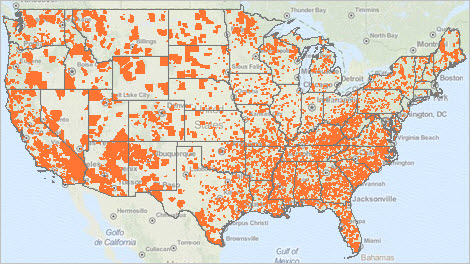 03.01.16. Options to Access Median Household Income (#MHI) by School District ... "tip of the day" program showing alternative ways to access and use $MHI ... how to get the most up-to-date data using ACS 2014 data. ... illustrates process using $MHI but applies to wide-ranging subject matter ... see http://proximityone.com/schooldistrict_mhi.htm 01.26.16. State Legislative District Data Analytics ... tools to analyze 2014 session state legislative district demographic-economic characteristics ... ACS 2014 5-year interactive tables & GIS projects & datasets ... see http://proximityone.com/sld14dp1.htm New York metro house districts & ZIP code $MHI patterns 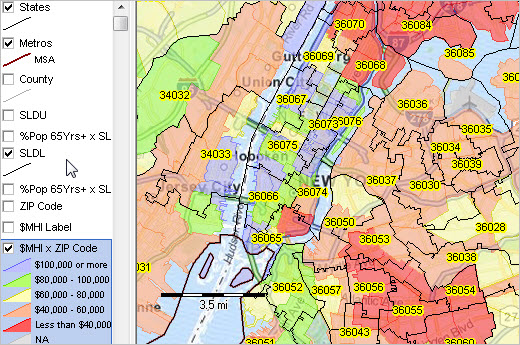 01.13.16. Crime Data Analytics ... integrating location-based crime data with demographic-economic data. ... summarizing crime data to block level; integrating ACS 2014 block group data ... GIS project & datasets ... see http://proximityone.com/crime_data_analytics.htm Patterns of crime by location & census block; Kansas City, MO  01.09.16. Linguistic Isolation by Block Group ... illustrating use of tools; Los Angeles County applications ... apply to any county: narrative, GIS project & datasets ... using 2014 ACS 5-year estimates ... see http://proximityone.com/linguistic_isolation_bg.htm Patterns of Linguistic Isolation; Los Angeles County, CA 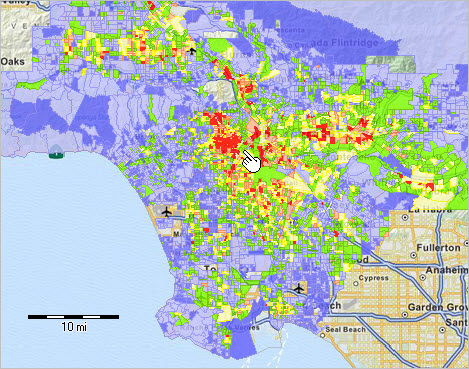 01.02.16. School District ACS 2014 5-year Estimates Interactive Tables ... interactive tables, datasets & GIS projects ... General Demographics ... Social Characteristics ... Economic Characteristics ... Housing Characteristics Percent Population 5-17 Years & Over by School District; South Central U.S. 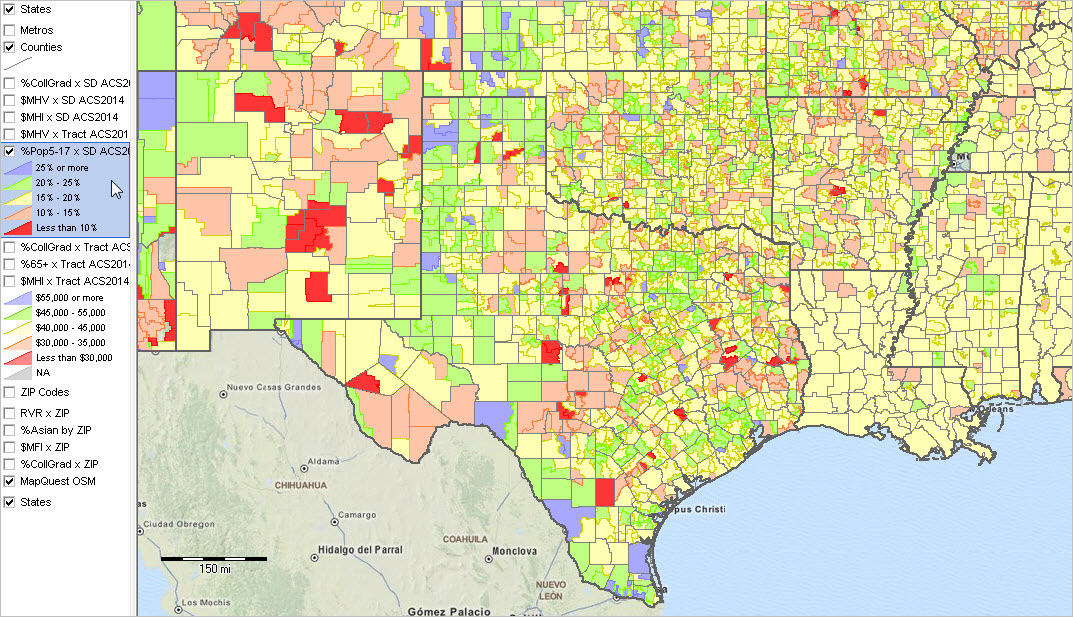 12.30.15. Census Tract ACS 2014 5-year Estimates Tables & Datasets ... interactive tables, datasets & GIS projects ... General Demographics ... Social Characteristics ... Economic Characteristics ... Housing Characteristics Percent Population 65 Years & Over by Tract  12.09.15. ZIP Code ACS 2014 5-year Estimates Tables & Datasets ... interactive tables, datasets & GIS projects ... General Demographics ... Social Characteristics ... Economic Characteristics ... Housing Characteristics rental vacancy rate by ZIP code; Detroit area 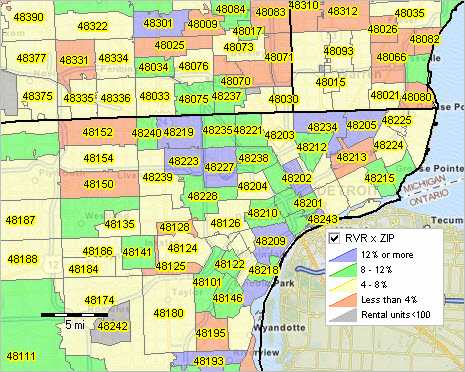 Reference • Tabulation Area Names & Geocodes (xls) • Questionnaire (pdf) • Group Quarters Questionnaire (pdf) • 2014 U.S. Gazetteer Files ... geography in these files matches the 2014 American Community Survey data Subject Matter Topics & Coverage ... scroll section Click link to access data & view more detail; opens new window.
Demographic
Age and Sex Group Quarters Population Hispanic or Latino Origin Race Relationship Total Population Housing Computer Ownership & Internet Access House Heating Fuel Kitchen Facilities Occupancy/Vacancy Status Occupants per Room Owner Monthly Costs Plumbing Facilities Rent Statistics Rooms Bedrooms Telephone Service Available Tenure Units in Structure Value of Home Vehicles Available Year Householder Moved Into Unit Year Structure Built Economic Class of Worker Commuting to Work/Journey to Work Employment Status Food Stamps/Supplemental Nutrition Assistance Program (SNAP) Health Insurance Coverage Income and Earnings Industry and Occupation Poverty Work Status Social Ancestry Citizenship Status Disability Status Educational Attainment Fertility Field of Degree Grandparents as Caregivers Language Marital History Marital Status Place of Birth School Enrollment Residence 1 Year Ago/Migration Veterans Year of Entry Scope of Geographic Areas Tabulated ... scroll section
Using ACS Data; ACS 1-Year versus ACS 5-Year Data [top] While ACS 1-year estimates are suitable for time-series analyses, the ACS 5-year estimates are not the same as annual demographic-economic estimates and may not be suitable for annual time series analyses. Advantages of using the 5-year estimates • the data are available for all census tracts and ZIP code areas. • the data are available for all cities/places, counties and school districts irrespective of size. Disadvantages of using the 5-year estimates • the data are older than the 1-year estimates. • the data are for a 5-year period rather than one year. • additional cautions in comparing estimates over time (see below). Advantages of using the 1-year estimates • the data are more recent than the 5-year estimates. • the data are generally more accurate than the 5-year estimates. Disadvantages of using the 5-year estimates • the data are not available for census tracts and ZIP code areas. • the data are available for only areas of 65,000 population and over. • the margin of error (MOE) of the estimate is normally larger that for the 5-year estimates. Additional cautions in comparing estimates over time • ACS 2012 5 year estimates are based on survey respondent data for the years 2008 through 2012. • ACS 2013 5 year estimates are based on survey respondent data for the years 2009 through 2013. • ACS 2014 5 year estimates are based on survey respondent data for the years 2010 through 2014. • The ACS 2012 5 year data & ACS 2013 5 year data are based on the same respondent data for the four years 2009 through 2012. • The ACS 2013 5 year estimates drop 2008 respondents and add 2013 respondents. • The ACS 2014 5 year estimates drop 2009 respondents and add 2014 respondents. • While 5-year estimates are independently developed annually, they include demographic-economic characteristics for some of the same respondents. • Geographic boundaries and/or geographic codes are often different for different ACS years/vintages. Examples: - February 2013 metros definitions are used for ACS 2013 & 2014; previous metro vintages are used for earlier ACS years - Current OMB definition metros will be used in ACS 2015 forward (until they change again) Other considerations • Are the needed subject matter available from Census 2010? - ACS more detailed demographic-economic data (like income) may not be a plus. • Census 2010 provides more accurate data than ACS estimates. • Often there are more detailed age (and other) breakouts for subject matter in Census 2010 compared to ACS. • The most recent ACS-sourced small area data are from ACS 2013 (2014 as of December 2015) 5-year estimates; - ACS 2013 (ACS 2014) estimates are centric to 2011 (2012) Data Resources 1. Demographic-Economic Profile Datasets - ready to use ProximityOne has developed annual Demographic-Economic Profile (DEP) datasets for ACS 2010 through ACS 2014. ProximityOne uses these data to develop current (2015) estimates and 5-year projections (to 2020). These datasets are available for the U.S. by state, county, congressional district, metropolitan area, city, school district, ZIP Code area and census tract.
AGE AND GENDER
D001 Total population D002 Male D003 Female D004 Under 5 years D005 5 to 9 years D006 10 to 14 years D007 15 to 19 years D008 20 to 24 years D009 25 to 34 years D010 35 to 44 years D011 45 to 54 years D012 55 to 59 years D013 60 to 64 years D014 65 to 74 years D015 75 to 84 years D016 85 years and over D017 Median age (years) D018 18 years and over D019 21 years and over D020 62 years and over D021 65 years and over D022 18 years and over D023 Male D024 Female D025 65 years and over D026 Male D027 Female RACE D028 Total population D029 One race D030 Two or more races D031 One race D032 White D033 Black or African American D034 American Indian and Alaska Native D035 Cherokee tribal grouping D036 Chippewa tribal grouping D037 Navajo tribal grouping D038 Sioux tribal grouping D039 Asian D040 Asian Indian D041 Chinese D042 Filipino D043 Japanese D044 Korean D045 Vietnamese D046 Other Asian D047 Native Hawaiian and Other Pacific Islander D048 Native Hawaiian D049 Guamanian or Chamorro D050 Samoan D051 Other Pacific Islander D052 Some other race D053 Two or more races D054 White and Black or African American D055 White and American Indian and Alaska Native D056 White and Asian D057 Black or African American and American Indian and Alaska Native Race alone or in combination with one or more other races D058 Total population D059 White D060 Black or African American D061 American Indian and Alaska Native D062 Asian D063 Native Hawaiian and Other Pacific Islander D064 Some other race HISPANIC OR LATINO AND RACE D065 Total population D066 Hispanic or Latino (of any race) D067 Mexican D068 Puerto Rican D069 Cuban D070 Other Hispanic or Latino D071 Not Hispanic or Latino D072 White alone D073 Black or African American alone D074 American Indian and Alaska Native alone D075 Asian alone D076 Native Hawaiian and Other Pacific Islander alone D077 Some other race alone D078 Two or more races D079 Two races including Some other race D080 Two races excluding Some other race, and Three or more races D081 Total housing units
EMPLOYMENT STATUS
E001 Population 16 years and over E002 In labor force E003 Civilian labor force E004 Employed E005 Unemployed E006 Armed Forces E007 Not in labor force E008 Civilian labor force E009 Percent Unemployed E010 Females 16 years and over E011 In labor force E012 Civilian labor force E013 Employed E014 Own children under 6 years E015 All parents in family in labor force E016 Own children 6 to 17 years E017 All parents in family in labor force COMMUTING TO WORK E018 Workers 16 years and over E019 Car, truck, or van -- drove alone E020 Car, truck, or van -- carpooled E021 Public transportation (excluding taxicab) E022 Walked E023 Other means E024 Worked at home E025 Mean travel time to work (minutes) OCCUPATION E026 Civilian employed population 16 years and over E027 Management, business, science, and arts occupations E028 Service occupations E029 Sales and office occupations E030 Natural resources, construction, and maintenance occupations E031 Production, transportation, and material moving occupations INDUSTRY E032 Civilian employed population 16 years and over E033 Agriculture, forestry, fishing and hunting, and mining E034 Construction E035 Manufacturing E036 Wholesale trade E037 Retail trade E038 Transportation and warehousing, and utilities E039 Information E040 Finance and insurance, and real estate and rental and leasing E041 Professional, scientific, and management, and administrative and waste management services E042 Educational services, and health care and social assistance E043 Arts, entertainment, and recreation, and accommodation and food services E044 Other services, except public administration E045 Public administration CLASS OF WORKER E046 Civilian employed population 16 years and over E047 Private wage and salary workers E048 Government workers E049 Self-employed in own not incorporated business workers E050 Unpaid family workers INCOME AND BENEFITS (IN 2010 INFLATION-ADJUSTED DOLLARS) E051 Total households E052 Less than $10,000 E053 $10,000 to $14,999 E054 $15,000 to $24,999 E055 $25,000 to $34,999 E056 $35,000 to $49,999 E057 $50,000 to $74,999 E058 $75,000 to $99,999 E059 $100,000 to $149,999 E060 $150,000 to $199,999 E061 $200,000 or more E062 Median household income (dollars) E063 Mean household income (dollars) E064 With earnings E065 Mean earnings (dollars) E066 With Social Security E067 Mean Social Security income (dollars) E068 With retirement income E069 Mean retirement income (dollars) E070 With Supplemental Security Income E071 Mean Supplemental Security Income (dollars) E072 With cash public assistance income E073 Mean cash public assistance income (dollars) E074 With Food Stamp/SNAP benefits in the past 12 months E075 Families E076 Less than $10,000 E077 $10,000 to $14,999 E078 $15,000 to $24,999 E079 $25,000 to $34,999 E080 $35,000 to $49,999 E081 $50,000 to $74,999 E082 $75,000 to $99,999 E083 $100,000 to $149,999 E084 $150,000 to $199,999 E085 $200,000 or more E086 Median family income (dollars) E087 Mean family income (dollars) E088 Per capita income (dollars) E089 Nonfamily households E090 Median nonfamily income (dollars) E091 Mean nonfamily income (dollars) E092 Median earnings for workers (dollars) E093 Median earnings for male full-time, year-round workers (dollars) E094 Median earnings for female full-time, year-round workers (dollars) HEALTH INSURANCE COVERAGE E095 .. Civilian Noninstitutionalized Population E096 .... With health insurance coverage E097 ...... With private health insurance coverage E098 ...... With public health coverage E099 .... No health insurance coverage E100 .... Civilian Noninstitutionalized Population Under 18 years E101 ...... No health insurance coverage E102 .... Civilian noninstitutionalized population 18 to 64 years E103 ...... In labor force: E104 ........ Employed: E105 .......... With health insurance coverage E106 ............ With private health insurance E107 ............ With public coverage E108 .......... No health insurance coverage E109 ........ Unemployed: E110 .......... With health insurance coverage E111 ............ With private health insurance E112 ............ With public coverage E113 .......... No health insurance coverage E114 ...... Not in labor force: E115 ........ With health insurance coverage E116 .......... With private health insurance E117 .......... With public coverage E118 ........ No health insurance coverage PERCENTAGE OF FAMILIES AND PEOPLE WHOSE INCOME IN THE PAST 12 MONTHS IS BELOW THE POVERTY LEVEL E119 All families E120 With related children under 18 years E121 With related children under 5 years only E122 Married couple families E123 With related children under 18 years E124 With related children under 5 years only E125 Families with female householder, no husband present E126 With related children under 18 years E127 With related children under 5 years only E128 All people E129 Under 18 years E130 Related children under 18 years E131 Related children under 5 years E132 Related children 5 to 17 years E133 18 years and over E134 18 to 64 years E135 65 years and over E136 People in families E137 Unrelated individuals 15 years and over ProximityOne User Group Join the ProximityOne User Group to keep up-to-date with new developments relating to metros and component geography decision-making information resources. Receive updates and access to tools and resources available only to members. Use this form to join the User Group. Support Using these Resources Learn more about accessing and using demographic-economic data and related analytical tools. Join us in a Data Analytics Lab session. There is no fee for these one-hour Web sessions. Each informal session is focused on a specific topic. The open structure also provides for Q&A and discussion of application issues of interest to participants. Additional Information ProximityOne develops geodemographic-economic data and analytical tools and helps organizations knit together and use diverse data in a decision-making and analytical framework. We develop custom demographic/economic estimates and projections, develop geographic and geocoded address files, and assist with impact and geospatial analyses. Wide-ranging organizations use our tools (software, data, methodologies) to analyze their own data integrated with other data. Follow ProximityOne on Twitter at www.twitter.com/proximityone. Contact us (888-364-7656) with questions about data covered in this section or to discuss custom estimates, projections or analyses for your areas of interest. | |||||||||||||||||||||||||||||||||||||||||||||||||||||||||||||||||||||||||||||||||||||||||||||||||||||||||||||||||||||||||||||||||||||||||||||||||||||||||||||||
|
|